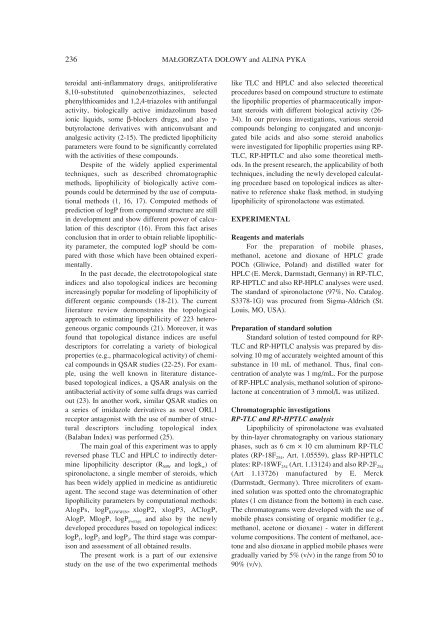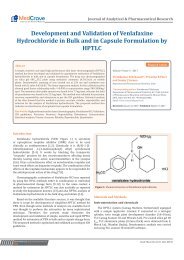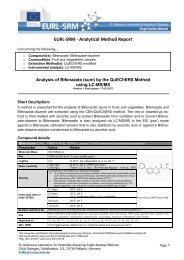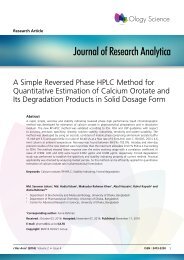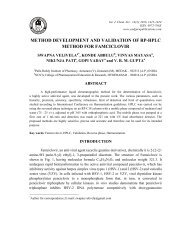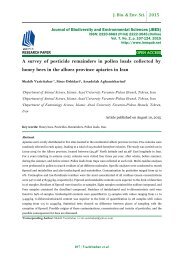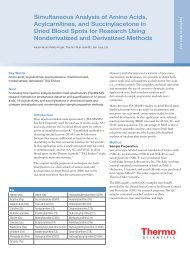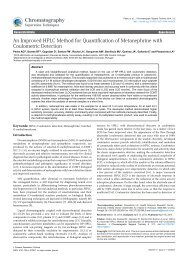acta 2_2015
acta 2_2015
acta 2_2015
- No tags were found...
You also want an ePaper? Increase the reach of your titles
YUMPU automatically turns print PDFs into web optimized ePapers that Google loves.
236 MA£GORZATA DO£OWY and ALINA PYKAteroidal anti-inflammatory drugs, anitiproliferative8,10-substituted quinobenzothiazines, selectedphenylthioamides and 1,2,4-triazoles with antifungalactivity, biologically active imidazolinum basedionic liquids, some β-blockers drugs, and also γ-butyrolactone derivatives with anticonvulsant andanalgesic activity (2-15). The predicted lipophilicityparameters were found to be significantly correlatedwith the activities of these compounds.Despite of the widely applied experimentaltechniques, such as described chromatographicmethods, lipophilicity of biologically active compoundscould be determined by the use of computationalmethods (1, 16, 17). Computed methods ofprediction of logP from compound structure are stillin development and show different power of calculationof this descriptor (16). From this fact arisesconclusion that in order to obtain reliable lipophilicityparameter, the computed logP should be comparedwith those which have been obtained experimentally.In the past decade, the electrotopological stateindices and also topological indices are becomingincreasingly popular for modeling of lipophilicity ofdifferent organic compounds (18-21). The currentliterature review demonstrates the topologicalapproach to estimating lipophilicity of 223 heterogeneousorganic compounds (21). Moreover, it wasfound that topological distance indices are usefuldescriptors for correlating a variety of biologicalproperties (e.g., pharmacological activity) of chemicalcompounds in QSAR studies (22-25). For example,using the well known in literature distancebasedtopological indices, a QSAR analysis on theantibacterial activity of some sulfa drugs was carriedout (23). In another work, similar QSAR studies ona series of imidazole derivatives as novel ORL1receptor antagonist with the use of number of structuraldescriptors including topological index(Balaban Index) was performed (25).The main goal of this experiment was to applyreversed phase TLC and HPLC to indirectly determinelipophilicity descriptor (R MW and logk w ) ofspironolactone, a single member of steroids, whichhas been widely applied in medicine as antidiureticagent. The second stage was determination of otherlipophilicity parameters by computational methods:AlogPs, logP KOWWIN , xlogP2, xlogP3, AClogP,AlogP, MlogP, logP average and also by the newlydeveloped procedures based on topological indices:logP 1 , logP 2 and logP 3 . The third stage was comparisonand assessment of all obtained results.The present work is a part of our extensivestudy on the use of the two experimental methodslike TLC and HPLC and also selected theoreticalprocedures based on compound structure to estimatethe lipophilic properties of pharmaceutically importantsteroids with different biological activity (26-34). In our previous investigations, various steroidcompounds belonging to conjugated and unconjugatedbile acids and also some steroid anabolicswere investigated for lipophilic properties using RP-TLC, RP-HPTLC and also some theoretical methods.In the present research, the applicability of bothtechniques, including the newly developed calculatingprocedure based on topological indices as alternativeto reference shake flask method, in studyinglipophilicity of spironolactone was estimated.EXPERIMENTALReagents and materialsFor the preparation of mobile phases,methanol, acetone and dioxane of HPLC gradePOCh (Gliwice, Poland) and distilled water forHPLC (E. Merck, Darmstadt, Germany) in RP-TLC,RP-HPTLC and also RP-HPLC analyses were used.The standard of spironolactone (97%, No. Catalog.S3378-1G) was procured from Sigma-Aldrich (St.Louis, MO, USA).Preparation of standard solutionStandard solution of tested compound for RP-TLC and RP-HPTLC analysis was prepared by dissolving10 mg of accurately weighted amount of thissubstance in 10 mL of methanol. Thus, final concentrationof analyte was 1 mg/mL. For the purposeof RP-HPLC analysis, methanol solution of spironolactoneat concentration of 3 mmol/L was utilized.Chromatographic investigationsRP-TLC and RP-HPTLC analysisLipophilicity of spironolactone was evaluatedby thin-layer chromatography on various stationaryphases, such as 6 cm ◊ 10 cm aluminum RP-TLCplates (RP-18F 254 , Art. 1.05559), glass RP-HPTLCplates: RP-18WF 254 (Art. 1.13124) and also RP-2F 254(Art 1.13726) manufactured by E. Merck(Darmstadt, Germany). Three microliters of examinedsolution was spotted onto the chromatographicplates (1 cm distance from the bottom) in each case.The chromatograms were developed with the use ofmobile phases consisting of organic modifier (e.g.,methanol, acetone or dioxane) - water in differentvolume compositions. The content of methanol, acetoneand also dioxane in applied mobile phases weregradually varied by 5% (v/v) in the range from 50 to90% (v/v).


